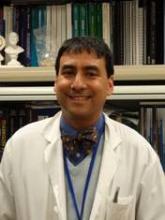Chronic hepatitis C virus infection is currently responsible for more U.S. deaths than HIV; is complicated to treat; is not vaccine preventable; and is a major driver of liver transplants, cirrhosis, chronic and end-stage liver disease, and liver cancer.
Although infection rates peaked more than a decade ago, rates of complications related to hepatitis C virus (HCV), such as cirrhosis, are projected to continue rising until 2020 or later (Gastroenterology 2010;138:513-21).
Amid this bad news, however, is emerging a remarkably promising treatment picture, said Dr. Marc Ghany of the liver diseases branch at the National Institute of Diabetes and Digestive and Kidney Diseases n Bethesda, Md.
At grand rounds at the NIH Clinical Center, Dr. Ghany told clinicians that, with the current Food and Drug Administration–approved regimens, "efficacy of therapy is improving and cure is now possible." The addition of direct-acting antiviral agents to regimens previously containing only peginterferon and ribavirin has been "a game-changer," Dr. Ghany said, with some patients achieving sustained virologic response (SVR) in as few as 12 weeks.
SVR is normally defined as testing negative for HCV-RNA 24 weeks after the end of treatment, Dr. Ghany said.
With chronic HCV infection, SVR is shorthand for cure, with nearly 100% of SVR patients having undetectable HCV-RNA over long-term follow-up (Clin. Infect. Dis. 2011;52:889-900). More importantly, "SVR is associated with improved outcomes," Dr. Ghany said, citing a large NIH multicenter study in which subjects who achieving SVR had vastly lower rates of decompensated liver disease, liver-related death, and liver transplantation. Liver cancer, while also reduced, was somewhat more persistent in the SVR population, meaning that people with SVR still need to be monitored for the development of cancer.
Triple therapies using peginterferon, ribavirin, and a direct-acting antiviral agent such as boceprevir or telaprevir, have increased the SVR rate to more than 75% among treatment-naive people with HCV genotype 1, the hardest of the six major genotypes to treat and the one responsible for the lion’s share of infections in the United States. With the earlier dual-therapy regimens, less than half of patients saw SVR, according to Dr. Ghany.
He described the current optimal therapy for HCV 1 infection as peginterferon alfa-2a 180 mcg weekly or peginterferon alfa-2b 1.5 mcg/kg weekly, plus oral ribavirin 800-1,400 mg in two divided doses daily, combined with either boceprevir 800 mg three times daily or telaprevir 750 mg every 8 hours.
Simple as they may sound, "these regimens are actually quite complex," Dr. Ghany said, with pill burdens as high as 18 a day. Nor are the agents interchangeable: the boceprevir and telaprevir regimens are administered very differently and must be adjusted within specific time frames according to patient response, he said.
Moreover, he said, "the side effects are substantial." Anemia (including severe anemia), neutropenia, and dysgeusia are all significantly higher with the boceprevir triple regimen than with the dual regimens, and telaprevir is associated with severe body rashes that only resolve when treatment is stopped. Cases of drug rash with eosinophilia and systemic symptoms (DRESS) and Stevens-Johnson syndrome also have been reported with telaprevir, he said.
Both regimens come with specific stopping rules for nonresponse, futility, and resistance prevention. These must be followed to the letter, Dr. Ghany said. Neither telaprevir nor boceprevir should ever be used as monotherapy, as resistance can develop in as little as 4 days. Clinicians should carefully consider the potential for drug interactions, particularly among transplant recipients or HIV-coinfected patients.
Optimal treatment times have not been established for people with cirrhosis, and one observational study showed significantly higher adverse effect rates for people with cirrhosis being treated with these regimens than were seen in phase III trials.
Dr. Ghany said that the decision whether to treat or observe can be difficult, and clinicians must consider the likelihood of disease progression, response, contraindications, disease stage, comorbidities, and side effects when working with a patient to choose the right course. Given the toxicity of some regimens, it might do to wait with some patients until safer therapies become available, he said.
Several all-oral regimens are now being tested that could eliminate the need for interferon. An interferon-free regimen is the "holy grail" of HCV treatment, Dr. Ghany said, pointing to a recent study of 21 patients in which SVR occurred after 12 weeks in 4 of 11 (36%) HCV-1 patients treated with a combination of two direct-acting antivirals. In a second group of 10 patients receiving these plus peginterferon and ribavirin, all had an SVR at 12 weeks after stopping therapy.

